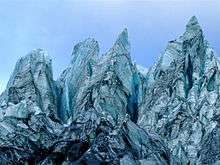Serac

A serac (originally from Swiss French sérac) is a block or column of glacial ice, often formed by intersecting crevasses on a glacier. Commonly house-sized or larger, they are dangerous to mountaineers, since they may topple with little warning. Even when stabilized by persistent cold weather, they can be an impediment to glacier travel.
Seracs are found within an icefall, often in large numbers, or on ice faces on the lower edge of a hanging glacier.[1] Notable examples of the overhanging glacier edge type are well-known obstacles on some of the world's highest mountains, including K2 at "The Bottleneck" and Kanchenjunga on the border of India and Nepal. Significant seracs in the Alps are found on the northeast face of Piz Roseg, the north face of the Dent d'Hérens, and the north face of Lyskamm.
Incidents
- On a 1969-1970 Japanese expedition to Mount Everest Kyak Tsering was killed by a falling serac.[2]
- In the August 2008 K2 disaster, the collapse of large seracs was responsible for at least 8 of the 11 mountaineers' deaths.[3]
- The April 2014 Mount Everest ice avalanche responsible for the deaths of 16 climbers was caused when a large serac broke off.
Gallery
- Serac, Russell Glacier in Greenland
 Seracs in firn at 3,050 metres (10,000 feet) on the Winthrop Glacier of Mount Rainier in Washington, USA
Seracs in firn at 3,050 metres (10,000 feet) on the Winthrop Glacier of Mount Rainier in Washington, USA- Seracs, Bossons Glacier, southeastern France
- Seracs, Bossons Glacier
- Seracs, Piloto Glacier, Cordillera Darwin, Tierra del Fuego
See also
References
- ↑ Post, Austin; Lachapelle, Edward R. (2000). Glacier Ice (Revised ed.). Seattle: University of Washington Press. ISBN 0-295-97910-0.
- ↑ "THE JAPANESE MOUNT EVEREST EXPEDITION, 1969-1970". HimalayanClub.org.
- ↑ Perlez, Jane (August 5, 2008). "More Are Feared Dead Near K2's Harsh Summit". The New York Times. Retrieved November 20, 2010.
| Wikimedia Commons has media related to Seracs. |
| Look up serac in Wiktionary, the free dictionary. |